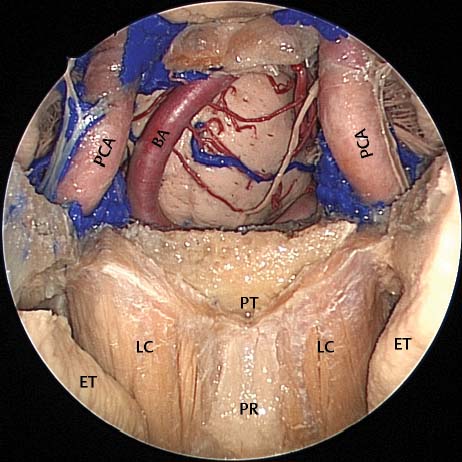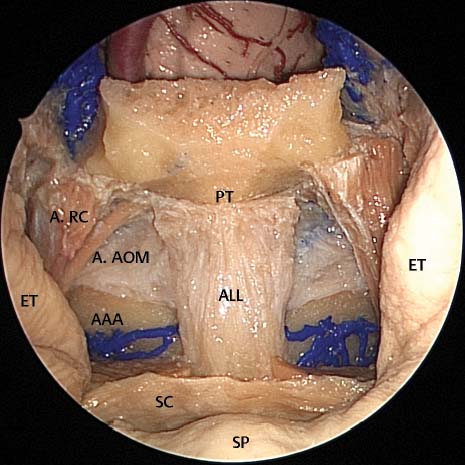21 Surgery on the craniocervical junction (CCJ) is complex due to its location behind the nasopharynx and difficult to access through traditional techniques. The traditional approach has been the transoral approach.1 This involves placing retractors in the mouth, opening the jaw, and retracting the tongue. Additionally the soft palate is split and portions of the hard palate are resected, depending on the access required. The disadvantages of this approach are the need for a pre- and postoperative tracheostomy to secure the airway, contamination of the surgical field with oral bacteria, the potential postoperative dysfunction of the soft palate in swallowing and phonation, and the need to feed the patient through a nasogastric tube postoperatively.2 The endoscopic approach avoids these problems as the surgery site is out of the swallowing mechanism, swelling is usually limited and does not threaten the airway, and oral bacteria are avoided.3 There are several pathologies that can be addressed with this approach. The most common condition affecting the CCJ is the development of a rheumatoid pannus in patients with rheumatoid arthritis. The inflammatory process in the rheumatoid pannus causes ligament laxity, bone erosion, and then, because the odontoid peg is no longer supported, it migrates into the brainstem causing compression by either direct pressure or by cervical subluxation. There are several congenital odontoid malformations, basilar invagination syndromes, and anomalies of the skull base that may affect the CCJ. Basilar invagination occurs when the tip of the odontoid moves more than 4.5 mm above a line drawn from the back of the hard palate to the base of the occiput (McGregor’s line).2 Chordomas arise in the bone of the clivus and upper cervical spine from notochord remnants and are the most common tumor of the mobile spine.2 These tumors rarely metastasize but are locally aggressive with bone destruction and neurologic involvement. Complete resection with postoperative proton beam irradiation provides the best long-term survival. These patients are treated initially with radiotherapy and usually respond well to this treatment. However, there are a small group of patients that fail multiple courses of radiotherapy and may need salvage surgery if the tumor involves this region. In addition, multiple courses of radiotherapy may result in radio-osteonecrosis of this region, which in turn may require surgical debridement. The CCJ consists of the region of the upper spine (C1 and 2) and the skull base (occiput) that articulates with C1. C1 (atlas) does not have a vertebral body or spinous process which in turn allows significant movement between the atlas and the skull base. This movement accounts for over half of the head’s axial rotation.4 The atlas has two thick lateral masses which articulate with the occipital condyles. The odontoid peg is positioned where the vertebral body of the atlas would normally be and fixed to the clivus by the apical and alar ligaments. As most surgery in this region involves exposure and resection of the odontoid, the ligamentous attachments and layers of the CCJ are important to understand. When this region is approached anteriorly the first layer encountered is the nasopharyngeal mucosa followed by the pharyngobasilar fascia, the longus capitis, and, more inferiorly, the longus coli muscles, atlanto-occipital membrane, anterior longitudinal ligament, atlanto-occipital ligaments, arch of the atlas, and odontoid peg (Figs. 21.1, 21.2, 21.3, and 21.4). The peg is supported by the apical and alar ligaments which form a secure attachment to the occipital bone/clivus (Fig. 21.5). Posterior to the odontoid, the cruciate ligaments (vertical and horizontal elements) provide strong support for the odontoid and prevent posterior displacement (Fig. 21.6). The cruciate ligaments are commonly affected by the rheumatoid pannus and weakened by the associated inflammation. Behind the cruciate ligaments is the tectorial membrane (Fig. 21.5). In Fig. 21.5 the anatomy is viewed from posterior with the tectorial membrane partially cut away to give a view of the cruciate ligaments. The superior aspect of the cruciate ligament is cut away to give a view of the apical and alar ligaments of the odontoid peg (dens). A parasagittal view is also provided demonstrating the layers from anterior to posterior in this complex area. Fig. 21.1 Cadaveric dissection following the removal of the mucosa and pharyngobasilar fascia. The middle third of the clivus has been removed to reveal the pons. The longus capitis (LC) muscles insert broadly onto the floor of the sphenoid sinus (removed in this specimen). The pharyngeal raphe (PR) can be seen attaching to the pharyngeal tubercle (PT) of the occipital bone. ET, eustachian tube; BA, basilar artery; PCA, paraclival artery. Fig. 21.2 Cadaveric dissection following the removal of the longus capitis muscles. This step reveals the anterior longitudinal ligaments (ALL), the anterior atlantooccipital membrane (A. AOM), and the anterior rectus capitis muscle (A. RC). Note how the superior constrictor (SC) muscle finishes at the level of the soft palate (SP). AAA, anterior arch of the atlas; ET, eustachian tube; PT, pharyngeal tubercle.
Endoscopic Surgery of the
Craniocervical Junction
 Pathology
Pathology
Rheumatoid Arthritis
Congenital Disorders
Chordoma
Nasopharyngeal Carcinoma
 Anatomy
Anatomy
Stay updated, free articles. Join our Telegram channel

Full access? Get Clinical Tree




